
|
British troops were told in lectures that the Japanese were small, myopic and technically backward. Popular cartoon images of the Japanese promoted the idea of tiny, strutting men in glasses brandishing samurai swords, with buck-toothed grins and slanted slits for eyes.
Col G.T. Wards, the British military attaché in Tokyo, on April 1941 gave a factual and frank account of the quality of the Japanese armed services to an audience of army officers in Singapore; highlighting among other things that the Japanese were fully aware of British weaknesses in the Far East. He was publicly contradicted and denigrated at the conclusion of his lecture by the GOC, Lt. Gen. Bond who later told him in private that "We must not discourage the chaps and we must keep their spirits up." The Japanese of course were not fooled by the deliberate bluff.
"I misjudged the Japs. I did not realise for a long time what
terribly efficient and serious soldiers they were."
"Everyone talks about fighting to the last man, but only the Japanese actually do it." Gen. Sir William Slim remarked during the Burma campaign in 1944
Japan attacked China because of low silk and high oil prices and because they wanted to build a large empire. In 1929, two-fifths of Japan’s export income came through selling silk to the US, but the depression destroyed that market. One reason for Japan attacking China was to try and get more resources so they wouldn’t have to depend on silk and to try and compensate for their losses. Another reason for war was a lack of oil. Oil was an important resource to the Japanese but unfortunately they had none of it. Japan attacked China, looking for more raw materials and land to build their empire.
"I think we grew too much. We had a large population with almost
no resources. Virtually the only things we could export were fish
and silk. We were okay until the 1920’s, but that’s when the US
stopped buying our silk. The price of silk plummeted and we had
to go to China to get other resources. I think in a way, we were
forced to fight in the war because we were either going to become
a modern nation by getting resources, or stay like we were, an
old fashioned farming country." /apwh/bios/i4tamura.htm |
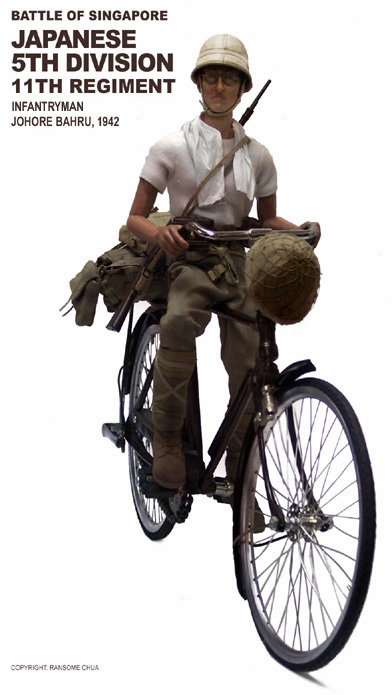
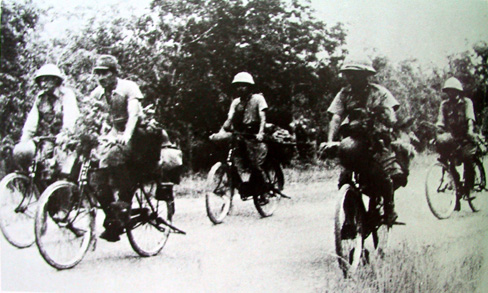
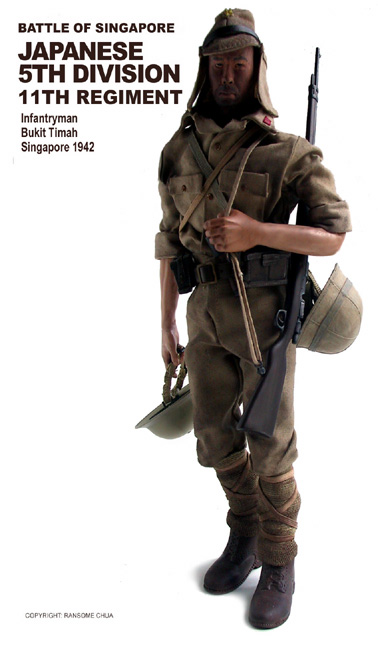
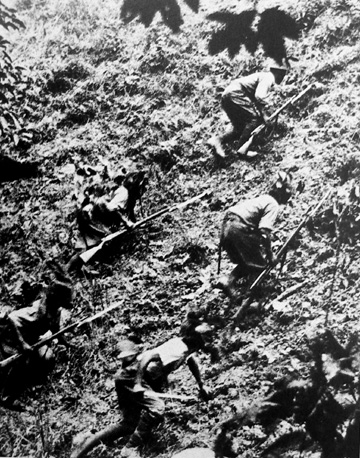
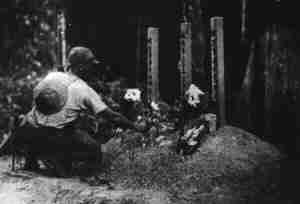
Offering at a gravesite for Japanese soldiers killed in action.
Mainichi Shimbun
Japanese soldiers advancing on a hillside in Singapore
Asahi Shimbun Company
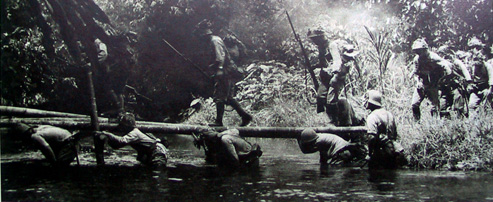
Fording a water obstacle.
Mainichi Shimbun
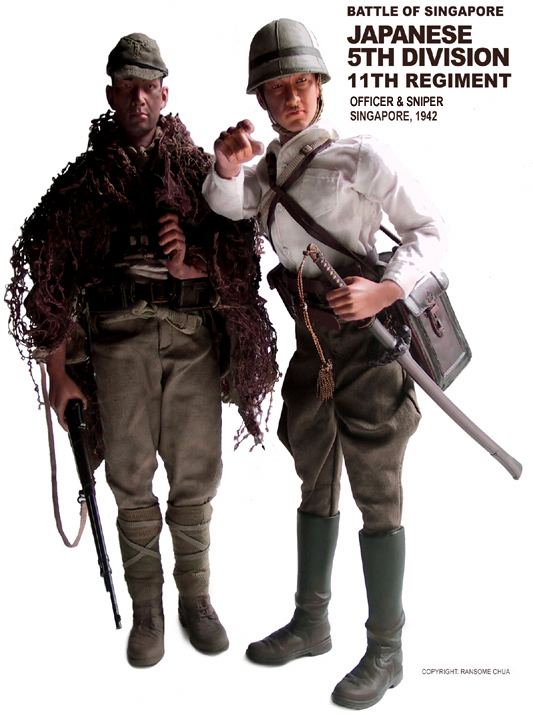
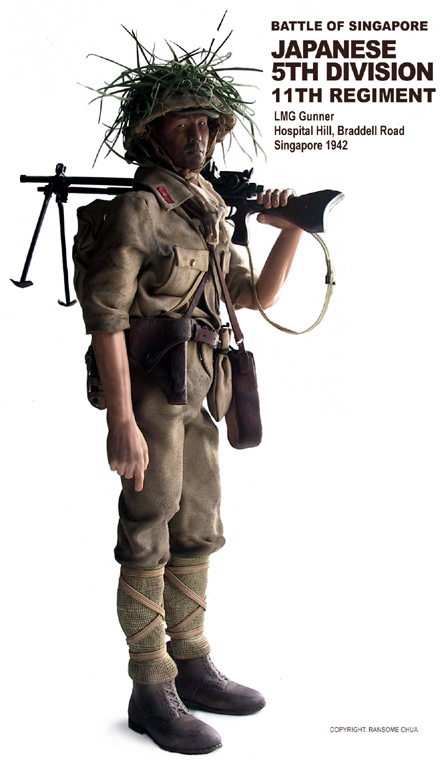
The Japanese soldier during the Malaya-Singapore campaign
The 3 Japanese divisions used in Malaya were not as, urban legend
had it, hardened jungle fighters simply for the fact that they
never had any experience of jungle fighting. What they had was
hard, rugged training on Hainan island off the south China coast
and in Indochina, to prepare them for their Malayan venture. The
fact that they were not jungle veterans was also not important
because the land on the western coast of the Malayan peninsula
was under intense cultivation with pineapple and oil palm plantations,
rice fields and rubber estates. These cultivations necessitated
a network of estate roads that were used by the Japanese to bypass
and outflank British positions on the trunk or main road. Tactically
mobile with bicycles, pack animals and fewer trucks, they were
also more adaptable in cross-country movement unlike the British,
who were dependant on wheeled vehicles and had to keep to the
roads. The Japanese were also very experienced in fording rivers
and streams.
The Japanese used veteran troops, 2 of the 3 divisions used in
the Malayan campaign had served in China; these men were physically
tough, confident, well trained and aggressively led and they were
prepared for close country warfare - which the British were not.
The Japanese also had command of the sea and air. One element
often not highlighted was the prowess of the Japanese soldier
in using psychological warfare to create the impression of being
a bigger force when outflanking the British forces. Troops were
deliberately spread out during a swift, intense attack to pop
up briefly and draw fire while the attacking party would break
into smaller groups to encircle the enemy. Booby traps, firecrackers
thrown into enemy positions, bogus commands given in English or
Urdu and exploding bullets were used to create the impression
of larger numbers and generate confusion in the ranks of the by-now
bewildered enemy.
All these were much important than the 'fanaticism' on the part of the Japanese soldier, characterised by Australian Gunner Russell Braddon, as "squat, compact figures with coarse puttees, canvas, rubber-soled, web-toed boots, smooth brown hands, heavy black eyebrows across broad foreheads, and ugly battle helmets. Each man wore two belts - one to keep his pants up and one to hold his grenades, his identity disc and his religious charm - and when they removed their helmets, they wore caps, and when they took off their caps, their heads had been shaved until only a harsh black stubble remained. They handled their weapon as if they had been born with them. They were the complete fighting animal."
Two interesting accounts of the Japanese soldier during World
War 2 are provided by writers Ralph Modder and Henry Frei:
In Modder's book - The Singapore Chinese Massacre - the Japanese
soldier is defined as "the 'ideal warrior,' fighting without food or water, trained
to live off the land so that supplying troops was never a major
problem at the outset of the war, sustaining himself on his ability
to withstand pain and hardship accepted as part of a soldier's
duty. He obeyed orders to commit suicide or to carry out suicide
attacks without question and was happy to know that he would die
like a hero for his Emperor. He was ready to be blown to pieces,
shot or horribly wounded. Above all, he welcomed death.
Prime Minister Tojo had made it clear that if a Japanese soldier
allowed himself to be taken prisoner, he should be executed even
if he escaped and rejoined his regiment. Furthermore, his family
would suffer the shame of his cowardice. Japanese army commanders
failed to understand why surrendered Allied troops who were in
good health should be treated with special care. To them, it just
didn't make sense.
The Japanese were not born with the fearsome and fearless qualities
that had made them such legendary warriors. They were moulded
into robot-like 'exterminators' by brutal training methods and
in indoctrination courses in which tyrannical instructors instilled
in recruits the belief of their 'superiority' as warriors; that
through suicidal acts in battle they would reach god-like status,
their spirits forever revered at Yasukuni Shrine in Tokyo, the
resting place of the spirits of all national heroes. The Japanese
soldier's duty was simply to obey orders. Death was part of it."
Indeed, death was part of a Japanese soldier's duty. Shortly after
midnight on the 8th of February, 1942, in the boat assault of
Singapore island, Leading Private Kioichi Yamamoto, one of the
coxswains steering his craft towards the enemy shore under fire
was probably under no illusions that he was not going to see through
this war alive. Halfway across the straits, he was hit by sharpnel
in the stomach, chest and right hand, probably from a mortar bomb.
His boat's steering damaged, the coxswain insisted on staying
at what was left of the wheel until the infantrymen in his vessel
disembarked on shore. Gasping for breath, Yamamoto then collapsed
and died but not before wishing His Imperial Majesty a long life
with a last 'Tenno haika banzai!' When he was picked up, it was discovered that his right lung
was protruding through his shattered rib cage and almost his entire
uniform was soaked with blood.
Sgt. Arai Mitsuo of the 18th Division was part of the second wave
when at about 1 a.m., jumping from the bow of his boat he felt
as he recollected in the 3rd person, "a cold hand stroked his ankle. Nine corpses floated in the water,
head upward, in a line next to each other. A chill ran down Arai's
spine. Were they shot while crossing, and then washed up, or after
they had landed? But reflections be hanged! Quick! Cut off a wrist
or a finger of each dead man. Chop, chop, chop. Into a box, there's
no time to bury them. Just a quick prayer. Rest in peace. Then
forward! He must fire the green 'success' rocket: Regimental Command
has landed - the sign for 18th Division Gen. Mutaguchi Renya to
embark on the third wave across the straits."
After a battle, prior to the corpses being buried, the wrists
or fingers of the Japanese dead were hacked off and put away in
a container for ossifying. During a lull, one would burn away
the flesh and give the bones to one of the deceased's close comrades
for him to take care of until the remains could be returned to
his hometown in an urn. Imperial Guard Tsuchikane recounts his
morbid experience, writing of himself in the third person:
"The platoon commander ordered him to cut off dead Captain Matsumoto's
wrist and lent him his company sword to do the job. It would not
cut. Tsuchikane tried again and again and finally the bone snapped.
They dropped the severed wrist into Matsumoto's mess tin and put
it carefully away into the ordnance bag of Senior Soldier Otsuka
who hailed from the same province... After a further battle, they
were able to rest in a bomb-out house. First they took from the
mess tin the dead Captain's hand and began to grill it. "Shuu,
shuu," it sizzled, with lots of grease escaping from the hand.
Strong smoke with a dreadful stench soon filled the room... Their
chopsticks got shorter, catching fire many times owing to their
efforts of turning the flesh and then burning away the muscle
from the bones...Picking the bones from the charcoal, they transferred
them to a British tobacco tin, which they passed to the safe-keeping
of their war buddies. They, in turn, put the bones in a white
cloth and stored the package with great care in their service
bag.... The soldiers had promised each other that they would enter
Singapore together, even if it were only their remains. They had
fought together until today, they had eaten the same rice, dived
under the same bullets, and they felt a bond no different from
that of brothers. Perhaps it was even stronger by knowledge of
man's fleeting existence experienced each day over the past months."
How were such fanaticism inculcated or bred in the soldiers of
the Imperial Japanese Army (IJA)? The samurai caste had already
been abolished in 1868 when Japan went to war in 1941. Modder
writes that Japanese premier General Hideki Tojo quickly "seized the opportunity to incorporate samurai ideals into the
Senjinkun (Warrior Code) that was taught to officers of the Imperial
Army whose harsh treatment of troops under them was a distortion
of the original ideals of bushido (Way of the Warrior). Troops
were ordered by their officers to make suicidal attacks against
enemy forces or fortifications, as had happened in China. In battle,
troops were expected to find the quickest way to end their lives
to avoid being taken prisoner. Also conveniently erased from the
original principles of bushido were 'courtesy and kindness. No
Western army was able to match the Japanese for courage. As Gen.
Sir William Slim remarked during the Burma campaign in 1944, "Everyone
talks about fighting to the last man, but only the Japanese actually
do it."
Writer Henry Frei, in his book Guns of February, which gives an intimate account of the ordinary Japanese soldier’s combat experiences during the battle for Singapore, focuses on the other hand, on the recollections and complex emotions of humanity, brutality, callousness and contritions of the Japanese soldier operating at the sharp end of war. Frei’s account goes beyond the conventional view of the Japanese soldier as a fanatic ready to die in the service of the Emperor, for he writes of the helplessness of some of the Japanese soldiers who were forced to obey military orders to commit atrocities against the Singapore Chinese civilian population during the Sook Ching (Purification through purge) massacre; "Now you must obey orders," the commander said. "You must now kill these Chinese." Kill. They had to kill them. Miyake and his collegues harboured no hostility against their assigned group. They couldn't stir up any hostile feelings. They had been done no harm by the Chinese people, they had no reason to take lives, no murderous intentions, they did not want to kill. They were human beings. People. To raise their will to kill the people, the officer in charge said: "You are about to kill these people by order of the highest general, the Emperor." Then he proceeded to cut off the heads of two of them. he did it with his sabre. The blood came out in a hissing sound - "shooo!" - and spurted two or three metres into the air, spraying around. Another 12 were beheaded, the rest stabbed... "The Emperor now orders you to kill..." Miyake never ceased asking himself: Does the Emperor have this right? Can he give such an order?
Frei notes that some of these veterans, in their old age, have
expressed remorse and contrition for perpetrating the atrocity.
One of these was former Kempeit-tai Lt. Onishi Satoru, "... Japan's biggest mistake at the beginning of the Occupation....
As a person who was involved, I feel as if stabbed by a knife,
aware of my responsibility towards the victims, to whom I offer
my sincere and deep condolences. I am not trying to justify or
excuse ourselves. The purge was a cruel act committed by the Japanese
Army. It constitutes truly shameful behaviour, and remains a most
disgraceful act in the Great Eastern War."
Machine-gunner Ochi recalls: "Japan was doing too well at the beginning of the war. The attack
on Pearl Harbour, the conquest of Singapore, the sea battles successes
off Malaya, the occupation of one place after the other in Indonesia,
and so on, each fed on the other and led to Japanese self-pride
and conceit. Drunk as they were on their sole object of winning
the war, generals were aiming at glory, their juniors at a rise
in career, the people at a net profit out of the war, each seeking,
with characteristic impatience and a quick temper, their own "net
profit." Yet, after their tiny victories, to get proud and arrogant
so quickly and to give free rein to self-interest and even public
black markets, was truly deplorable. If such Japanese had controlled
and ruled Asia, it would have become a miserable and pitiful place,
indeed.
The Japanese had not yet evolved into a constitutional people.
So there was really no reason to challenge the United States or
great Britain who were already constitutional peoples. The biggest
reason for Japan's defeat was her backwardness. It was good that
Japan was defeated. Japan can now completely reform and remodel
itself and its cultural standards. It's the young that must do
this. Only the young can complete and achieve this."
However, in retrospect, the absence of moral courage among Japanese
soldiers to defy unlawful military orders showcased the moral
degradation and depravity of the Imperial Japanese Army. Evidence
of the callousness and brutality of the Japanese soldier is provided.
In one instance, Imperial guardsmen had mistakenly fired on Malayan
civilians. Instead of rendering first aid to the badly injured
survivors, the guardsmen systematically finished them off one
by one on dubious mercy killing grounds. It was clear that the
fanatical fighting spirit of the Japanese soldier also inured
him to indignities inflicted upon enemy civilians and surrendering
soldiers.
Imperial Guard Tsuchikane relates his platoon's first contact
with the Australians after landing and marching inland towards
the Mandai area: "Amid the platoon's murderous yells, Tsuchikane hurled himself
forward, straight into the enemy position. Many of the Australian
27th Brigade were already turning their backs to him. Tsuchikane
closed in on one, ran after him, pulled him to the ground, and
with his bayonet pierced his opponent from the back of his shoulder
out through the front. The enemy expired with a deathly yell,
as Tsuchikane pulled out the blade, splattering his jacket with
a crimson red.
The Australian position had stood on a slight rise and the Aussies
had put its height to good use by concentrating heavy flank fire
from a fixed position down onto the approaching Japanese enemy.
Many of the dead lay just beneath the rise. Having lost their
minds, some of the defenders had simply been cowering in terror,
trying to squat down and avoid hand-to-hand combat. They, too,
were bayoneted and shot without mercy.
The company captured a number of heavy machine-guns and 18 prisoners
of war, several among whom were British, including a red-bearded
officer. The prisoners, however, were dangerous baggage. Taking
them into the next battle would greatly hamper tactics. They would
require several guards at a time when the attackers themselves
had suffered 60 dead and wounded and the battle for Singapore
was just beginning. Fortunately, an artillery unit in the rear
was willing to accept the 18 prisoners, to the great relief of
the Imperial Guard company.
Remembering the sordid incidences by Japanese troops in China,
Gen. Yamashita's first order to the Japanese invasion forces assembled
at Sanya in Hainan Island prior to the start of the invasion,
was "no looting, no rape, no arson." The general made it clear that any soldiers committing such crimes
would be severely punished and their superior officers held accountable.
Some of Yamashita's fears were realised when Japanese troops occupied
the Malayan island of Penang on the 19th December, 1942. Incidents
occurred in which some soldiers committed the crimes of looting
and raping, despite notice given on 11 December that military
discipline would be strictly enforced. These soldiers involved
were ordered to be severely punished and their regimental and
battalion commanders disciplined. In his diary, Yamashita wrote
angrily, deploring the fact that his orders had not been heeded
by soldiers and stressing that the re-education of the Japanese
in discipline and morality was necessary.
References:
Ralph Modder, The Singapore Chinese Massacre, Horizon Books Pte Ltd, Singapore, 2004
Henry Frei, Guns of February: Ordinary Japanese Soldiers’ Views of the Malayan Campaign and the Fall of Singapore 1941 - 42, Singapore University Press, 2004
Brian Farrel & Sandy Hunter, Sixty Years On - The Fall of Singapore
Revisited, Eastern Universities Press, 2004
www.mindef.gov.sg/imindef/publications/pointer/journals/2004/v30n4/book_review.html
www.malaysia-today.net/books/2006/03/20a-japanese-invasion-ibrahim-yaakubs.htm
|
Japanese Invasion: Ibrahim Yaakub’s recollections of Japanese
soldiers They came to Matang in search of food, especially chicken, ducks
and eggs. Chinese folks, who stocked rice and flour in their homes,
hurriedly bundled them up in water proof containers before lowering
them into the water. Some, in complete fear and panic, just threw
whatever they had into the water. Girls and young women slipped into the water under their homes
through openings made in the floorboards. Once the Japanese troops
had left, they climbed back into their homes once again. That
was the scene in Matang, which happened to be under flood waters.
I saw these spectacles from my hiding place across the river. Japanese soldiers, who arrived in trucks or on bicycles (the bicycle
brigades), were seen bashing a few Chinese who refused to part
with their possessions. Bicycles were simply snatched away or
exchanged with Japanese ones. Japanese soldiers loved bicycles
which were made in England especially the speedy Raleigh to
chase after enemies called Inggerisu (Englishmen). No one desired their Japanese-made bicycles, even
when given free. Only one bicycle in Matang, even being brand
new, escaped confiscation. It belonged to an Indian Public Works
Department supervisor. Many a Japanese soldier had grabbed the
new bicycle with a big grin, but when they measured the distance
between the seat and the pedal, they returned the bicycle with
a snigger and an “Arigato” (thank you). At 28 inches, it was too high for the Japanese soldiers,
who were, by and large, very short." |